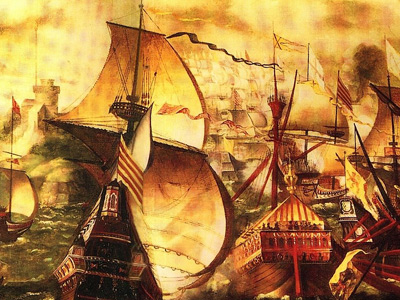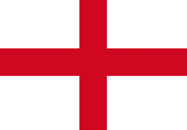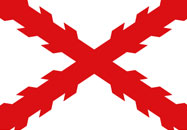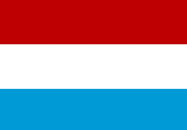Spanish Armada (1588)
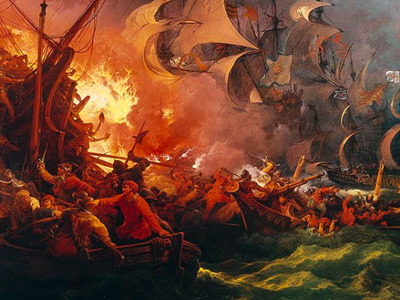
Planned Invasion of England
Prior to the undertaking, Pope Sixtus V allowed Philip II of Spain to collect crusade taxes and granted his men indulgences. The blessing of the Armada's banner on 25 April 1588, was similar to the ceremony used prior to the Battle of Lepanto in 1571. On 28 May 1588, the Armada set sail from Lisbon and headed for the English Channel. The fleet was composed of 130 ships, 8,000 sailors and 18,000 soldiers, and bore 1,500 brass guns and 1,000 iron guns. The full body of the fleet took two days to leave port. It included twenty eight purpose-built warships, of which twenty were galleons, four galleys and four (Neapolitan) galleasses. The remainder of the heavy vessels were mostly armed carracks and hulks together with thirty-four light ships.
In the Spanish Netherlands, 30,000 soldiers awaited the arrival of the Armada, the plan being to use the cover of the warships to convey the army on barges to a place near London. All told, 55,000 men were to have been mustered, a huge army for that time. On the day the Armada set sail, Elizabeth's ambassador in the Netherlands, Valentine Dale, met Parma's representatives in peace negotiations. The English The Kingdom of England was a sovereign state on the island of Great Britain from about 927, when it emerged from various Anglo-Saxon kingdoms, until 1 May 1707, when it united with Scotland to form the Kingdom of Great Britain. The Viking invasions of the 9th century upset the balance of power between the English kingdoms, and native Anglo-Saxon life in general. The English lands were unified in the 10th century in a reconquest completed by King Æthelstan in 927. made a vain effort to intercept the Armada in the Bay of Biscay. On 6 July negotiations were abandoned, and the English fleet stood prepared, if ill-supplied, at Plymouth, awaiting news of Spanish
The Kingdom of England was a sovereign state on the island of Great Britain from about 927, when it emerged from various Anglo-Saxon kingdoms, until 1 May 1707, when it united with Scotland to form the Kingdom of Great Britain. The Viking invasions of the 9th century upset the balance of power between the English kingdoms, and native Anglo-Saxon life in general. The English lands were unified in the 10th century in a reconquest completed by King Æthelstan in 927. made a vain effort to intercept the Armada in the Bay of Biscay. On 6 July negotiations were abandoned, and the English fleet stood prepared, if ill-supplied, at Plymouth, awaiting news of Spanish The Spanish Empire was a colonial empire governed by Spain and its predecessor states between 1492 and 1976. One of the largest empires in history, it was the first to usher the European Age of Discovery and achieve a global scale, controlling vast territory. It was one of the most powerful empires of the early modern period, reaching its maximum extent in the 18th century. movements. The English fleet outnumbered the Spanish, 200 ships to 130, while the Spanish fleet outgunned the English – its available firepower was 50% more than that of the English. The English fleet consisted of the 34 ships of the Royal Fleet (21 of which were galleons of 200 to 400 tons) and 163 other ships (30 of which were of 200 to 400 tons and carried up to 42 guns each), 12 of these were privateers owned by Lord Howard of Effingham, Sir John Hawkins and Sir Francis Drake.
The Spanish Empire was a colonial empire governed by Spain and its predecessor states between 1492 and 1976. One of the largest empires in history, it was the first to usher the European Age of Discovery and achieve a global scale, controlling vast territory. It was one of the most powerful empires of the early modern period, reaching its maximum extent in the 18th century. movements. The English fleet outnumbered the Spanish, 200 ships to 130, while the Spanish fleet outgunned the English – its available firepower was 50% more than that of the English. The English fleet consisted of the 34 ships of the Royal Fleet (21 of which were galleons of 200 to 400 tons) and 163 other ships (30 of which were of 200 to 400 tons and carried up to 42 guns each), 12 of these were privateers owned by Lord Howard of Effingham, Sir John Hawkins and Sir Francis Drake.
The Armada was delayed by bad weather. Storms in the Bay of Biscay forced four galleys and one galleon to turn back, and other ships had to put in for repairs, so only about 123 or 124 ships actually made it to the English Channel. Nearly half the fleet were not built as warships and were used for duties such as scouting and dispatch work, or for carrying supplies, animals, and troops.
The fleet was not sighted in England until 19 July, when it appeared off The Lizard in Cornwall. The news was conveyed to London by a system of beacons that had been constructed all the way along the south coast. On that evening, the English fleet was trapped in Plymouth Harbour by the incoming tide. The Spanish convened a council of war, where it was proposed to ride into the harbour on the tide and incapacitate the defending ships at anchor and from there to attack England; but Medina Sidonia declined to act because this had been explicitly forbidden by Philip, and decided to sail on to the east and towards the Isle of Wight. As the tide turned, 55 English ships set out to confront them from Plymouth under the command of Lord Howard of Effingham, with Sir Francis Drake as Vice Admiral. Howard ceded some control to Drake, given his experience in battle. The rear admiral was Sir John Hawkins.
HISTORY
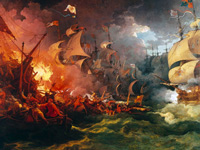
RESOURCES
This article uses material from the Wikipedia article "Spanish Armada", which is released under the Creative Commons Attribution-Share-Alike License 3.0.
© Stories Preschool. All Rights Reserved.
